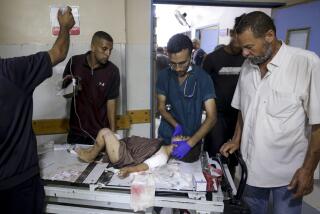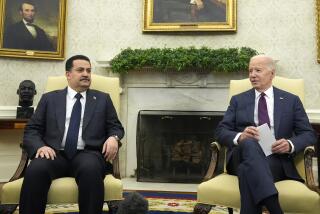Iraq Pledges to Pull Back; U.S. Is Skeptical, Sends More Planes : Mideast: Clinton says Hussein has lied repeatedly and there is no evidence yet of troop withdrawal from Kuwaiti border. Call-up of National Guard and reserves weighed.
- Share via
WASHINGTON — President Clinton on Monday ordered an additional 350 U.S. combat aircraft to the Persian Gulf, despite a pledge from Saddam Hussein to pull back his troops from Iraq’s border with Kuwait.
Clinton said that he is bolstering U.S. forces in the region because Hussein has repeatedly lied in the past about his intentions and because the United States does not yet have intelligence supporting the Iraqi leader’s promise to withdraw his forces.
“We’re interested in facts, not promises--in deeds, not words,” Clinton said in a six-minute address to the nation Monday evening. “We have not yet seen evidence that Iraq’s troops are, in fact, pulling back.”
Iraq’s U.N. ambassador announced earlier in the day that Baghdad will begin withdrawing its estimated 80,000 soldiers from the Kuwaiti border area rather than face a military confrontation with the United States over concerns about an attack on Kuwait.
Iraqi Ambassador Nizar Hamdoun told reporters at the United Nations that he had notified the Security Council formally that “the instructions have already been issued and the troops are already on the move.” But he declined to answer questions about specifics.
Pentagon officials said that the additional aircraft include six long-range B-52 bombers, 12 F-117A Stealth fighter-bombers and 36 F-15E ground-attack jets, which will be sent to air bases in Kuwait and Saudi Arabia. Clinton also dispatched 42 A-10 Warthog antitank aircraft, 66 F-16 fighters, 18 F-111F bombers, 54 AH-64 Apache attack helicopters as well as reconnaissance, electronic surveillance and tanker planes.
The latest additions will bring the number of U.S. aircraft in the region--including Navy warplanes on the aircraft carrier George Washington in the Red Sea--to 661, a powerful force by any measure.
Military experts said that the B-52s were sent to allow saturation bombing of troops and equipment, while the F-117As and F-15Es would provide added night vision and bad-weather capability.
Administration officials said that Clinton also is weighing the call-up of National Guard and reserve troops to support the armor and Marine units that are en route to the area. In all, the United States could have more than 38,000 troops in the Persian Gulf by the end of the week.
Administration officials, though relieved by the Iraqi announcement of a pullback, said it was too early to tell whether Iraq actually had begun withdrawing its troops, particularly since it was night in Iraq. One senior official said that there were some indications early in the day that additional forces were moving toward the Kuwaiti border, rather than away from it.
“Because of what happened in 1990,” Clinton said, referring to Hussein’s lightning attack on Kuwait in August of that year, “this provocation requires a strong response from the United States and the international community. . . . We will not allow Iraq to threaten its neighbors or intimidate the United Nations.”
Officials said the Administration probably would insist that Hussein move his forces back to a “non-threatening” position. But it was not clear whether the United States would set a deadline or provide specifics on what that means.
“We are discussing the parameters of their future behavior” and probably will go to the United Nations to seek limits on aggressive Iraqi troop movements, a senior White House aide said Monday night.
Another Administration official said that U.S. ground troops would stay in the region for some time even if Baghdad withdraws its forces. But he added, “I don’t believe the President has any desire to keep American forces over there any longer than necessary.”
The official said that the President is determined to deter an attack or defend Kuwait and had not yet focused on what new restraints to try to impose on Hussein.
Clinton canceled a political trip to New Jersey to remain in Washington to discuss the Persian Gulf crisis with his senior national security advisers.
White House Press Secretary Dee Dee Myers said that Clinton spoke by telephone with six foreign leaders Sunday and Monday about the Iraq situation, and that all were supportive of the U.S. response.
He also called former President George Bush, who led the 1991 war that drove Iraq from Kuwait, to thank him for supporting his actions in the current crisis and to say that Bush’s pre-positioning of large numbers of U.S. tanks and artillery in Kuwait was critical to the swift American response.
Clinton spoke Sunday evening with Saudi Arabia’s King Fahd. On Monday, Clinton spoke with Russian President Boris N. Yeltsin, French President Francois Mitterrand, Egyptian President Hosni Mubarak, British Prime Minister John Major and Turkish Prime Minister Tansu Ciller.
Ciller, who called Clinton, pledged cooperation but did not grant permission to use Turkish airfields to launch U.S. air raids.
Military officials said that U.S. reconnaissance satellites have not picked up any signs that Iraqi forces actually had begun to withdraw but that no conclusions about this could yet be drawn.
One reason is that Iraq’s internal communications are more primitive than those of the United States and the Iraqi army may not be as responsive as Western military organizations. “We don’t even know for sure yet that they’re getting the orders,” one official said.
The Iraqi announcement effectively put on hold this sudden crisis, which began in midweek when signs of troops massing near the border alarmed Kuwait and U.S. officials. By the time it turned around Monday, Baghdad had massed about 80,000 troops, many of them fully equipped.
But the new turn of events also leaves U.S. strategists with a knotty problem--what to do if Hussein decides to taunt the United States by withdrawing his forces an inch at a time, forcing Washington to keep its troops in the region for months.
Defense Secretary William J. Perry already has warned that the United States will not permit Iraq to force U.S. troops to “linger” in the Persian Gulf area. But strategists said that the Pentagon still has not worked out specifics on how to enforce that warning.
Private defense analysts speculated that U.S. forces could prod the Iraqis, if necessary, by bombing a command-and-control center or barracks building or by taking other steps to punish inadequate response.
However, military experts said that the United States would have to maintain a credible strike force if it takes such action because Iraq could reverse course again and move on Kuwait.
President Clinton spent the afternoon conferring with his top national security aides--Perry, National Security Adviser Anthony Lake and Gen. John M. Shalikashvili, chairman of the Joint Chiefs of Staff--but no decisions were announced.
Meanwhile, any remaining hope that the Security Council might ease its economic embargo against Iraq dimmed further as a U.N. commission prepared to recommend that Baghdad be required to meet additional tests on eliminating its weapons of mass destruction.
The panel, headed by Swedish diplomat Rolf Ekeus, said that its technicians have essentially completed setting up a monitoring system that will enable the United Nations to ensure that Iraq does not attempt to rebuild its arsenal and praised Baghdad for helping in the effort.
At the same time, however, it suggested that the Security Council withhold action on lifting the economic embargo until Iraq also has shown definitively that it will cooperate in monitoring and verification efforts. And it did not say how long the test period should be.
Times staff writer Stanley Meisler contributed to this article.
* KUWAIT NOT CONVINCED: Kuwait wants proof of Iraq’s professed pullback. A6
* RELATED STORIES, A6-13
More to Read
Sign up for Essential California
The most important California stories and recommendations in your inbox every morning.
You may occasionally receive promotional content from the Los Angeles Times.










